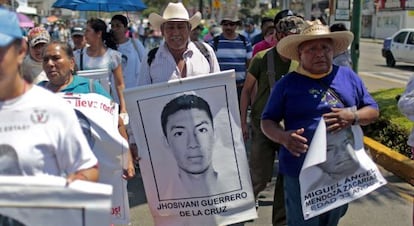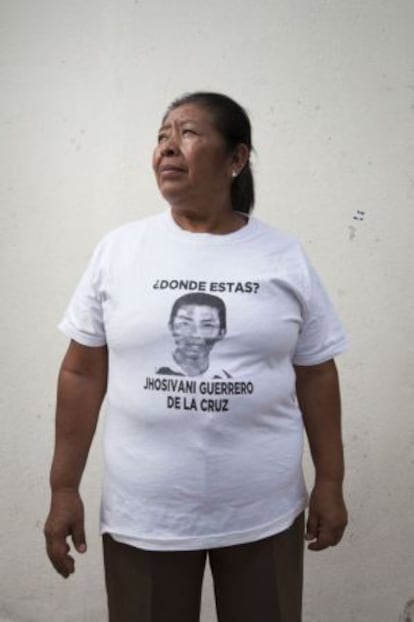Mexico confirms identity of second missing student teacher
Attorney general says DNA testing has identified remains of Jhosivani Guerrero


He was 20 years old, his name was Jhosivani Guerrero de la Cruz, and his name has just been crossed off the list of student teachers from Ayotzinapa who have been missing in Iguala since September 26, 2014. It has now been added to the list of the dead.
Mexican Attorney General Arely Gómez said on Wednesday that DNA testing carried out at the University of Innsbruck in Austria has confirmed that human remains found by investigators belonged to the young student teacher. He is the second victim of that mass kidnapping whose death has been confirmed, after Mexican officials also identified 21-year-old Alexander Mora Venancio.
Forensic experts say that as time passes it will become more difficult to identify the bodies
A total of 41 students remain missing, but forensic experts say that as time passes it will become more difficult to identify the bodies.
The discovery of Jhosivani Guerrero’s remains has given the Mexican government some breathing room. According to the authorities’ theory of what happened to the teaching students, they were arrested by police in Iguala, taken to a police station, and then they were handed over to a group of hitmen from the Guerreros Unidos cartel. These gunmen are alleged to have brutally murdered them before burning their bodies at a dumping ground in the nearby town of Cocula. They stuffed the remains into garbage bags and threw them into San Juan River to eliminate all traces of evidence. It was the discovery of one of these bags that allowed the authorities to identify some of the remains through DNA testing.

But the victims’ families do not trust the government’s version of events. The fact that none of the remains found in Cocula gave a positive DNA reading only makes them more suspicious. What’s more, experts commissioned by the Organization of American States (OAS) published a report earlier this month saying there was no evidence of an actual fire at the dump site.
Faced with such strong refutation, the Mexican government has reacted with caution. Aware of the emotional volatility the case inspires and on the eve of his meeting with the families, Mexican President Enrique Peña Nieto and his administration decided to follow OAS recommendations, extending the investigation and allowing forensic experts to re-examine the dumping site. Still, these latest findings have hurt the government’s credibility.
The identification of the second body may strengthen the official account of events but the experts in Innsbruck say it will be difficult to identify more remains given that the perpetrators burned the corpses at very high temperatures, destroying all traces of DNA in most of the bones the Austrian laboratory received.
The gunmen are alleged to have brutally murdered the student teachers before burning their bodies at a dumping ground
Meanwhile, the students’ families have yet to react to the news. Jhosivani Guerrero, who was nicknamed “The Korean” because of his almond-shaped eyes, was like many of his schoolmates. He was from a poor peasant family whose only opportunity for dignified work was the Rural Teachers’ College of Ayotzinapa. The school has been a source of radical leftist movements for decades and it has borne the brunt of the chaos in Guerrero like few other institutions. This poor state, where people are still grappling with violence, was the scene of a savage dirty war in the 1970s. The memory of a repressive campaign backed by state officials which led to hundreds of disappearances is still fresh in the minds of the victims’ families and it is still palpable within the walls of that school in Ayotzinapa.
English version by Dyane Jean Francois.
Tu suscripción se está usando en otro dispositivo
¿Quieres añadir otro usuario a tu suscripción?
Si continúas leyendo en este dispositivo, no se podrá leer en el otro.
FlechaTu suscripción se está usando en otro dispositivo y solo puedes acceder a EL PAÍS desde un dispositivo a la vez.
Si quieres compartir tu cuenta, cambia tu suscripción a la modalidad Premium, así podrás añadir otro usuario. Cada uno accederá con su propia cuenta de email, lo que os permitirá personalizar vuestra experiencia en EL PAÍS.
¿Tienes una suscripción de empresa? Accede aquí para contratar más cuentas.
En el caso de no saber quién está usando tu cuenta, te recomendamos cambiar tu contraseña aquí.
Si decides continuar compartiendo tu cuenta, este mensaje se mostrará en tu dispositivo y en el de la otra persona que está usando tu cuenta de forma indefinida, afectando a tu experiencia de lectura. Puedes consultar aquí los términos y condiciones de la suscripción digital.
Últimas noticias
Maduro pleads not guilty before the federal court in New York: ‘I am still the president of Venezuela’
A new test can detect Alzheimer’s from a finger prick
UN team enters Sudanese city of El Fasher after paramilitary massacre: ‘It’s like a ghost town’
A recipe for resistance: Indigenous peoples politicize their struggles from the kitchen
Most viewed
- Gilles Lipovetsky: ‘If you want to live better and fall in love, take Prozac, don’t look to philosophy’
- Alain Aspect, Nobel laureate in physics: ‘Einstein was so smart that he would have had to recognize quantum entanglement’
- Alvin Hellerstein, a 92-year-old judge appointed by Bill Clinton, to preside over Maduro’s trial in New York
- Maduro’s downfall puts China’s relationship with Venezuela to the test
- Why oil has been at the center of Venezuela-US conflicts for decades








































